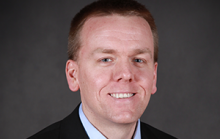In 2014, the Boston Fed initiated a threat-sharing model for small-and medium-sized depository institutions whereby organizations convene bi-weekly to collectively share information about emerging cyber-threats, solutions, and best practices. This approach effectively turned competitors into collaborators, and it has succeeded in minimizing risks and improving cybersecurity protection plans for the 61 financial institutions involved today.

Don Anderson, CIO of the Federal Reserve Bank of Boston, recently took home the Nonprofit CIO of the Year award from the Boston CIO Leadership Association for his work in leading these efforts and more. We asked Anderson to share why he believes in a collaborative approach and how that feeds into his leadership philosophy for IT.
![]()
The Enterprisers Project (TEP): Can you explain why a collaborative approach to cybersecurity was the right way to go and what it helped you achieve?

Anderson: While every company is in a constant struggle to be first to market, differentiate services, or gain competitive advantage, the criminals behind cybercrime largely focus on one thing: financial gain – and these malicious actors don’t really care about their target or after effects. Criminals seem to have limitless resources, and more importantly, a much larger financial incentive than any one organization.
For organizations to successfully protect themselves, cybersecurity has to be an area of strong intra-industry collaboration – not competition. If a competitor becomes the victim of a cybercrime, the impact will likely be felt across the industry as labels get applied with a broad brush. Initially, for some, this new approach was a significant cultural shift that required close partnerships between security and legal teams to allow for information sharing and transparency. Today, our forum has over 100 participants from 61 institutions across New England.
Enabling collaborative relationships supports of our overarching mission to ensure the stability of the financial services industry. In addition to the trusted peer-to-peer relationships that are fostered in this environment, we leverage these relationships to help us improve, too. Routinely, we identify key risks or gaps in protection and develop response plans for our own cybersecurity – and while doing so, share the action plans with our networks so that: (1) our partners can learn from us if they face a similar risk, and (2) our partners seek input on how to most effectively and efficiently respond.
TEP: How do you encourage your team to embody a collaborative mindset on a day-to-day basis?
Anderson: The Boston Fed’s culture fosters a collaborative and inclusive environment. Whether a team member has been with the bank for a long or short tenure, each person possesses a very diverse set of experiences they’re willing to share. When it comes to collaboration, it’s just a matter of getting the right people together, and they take care of the rest. In a consensus-driven organization like the Fed, much time is spent socializing ideas, receiving input, and reaching agreement. I encourage teams to be bold and to forget about what we’ve tried in the past – whether the end result was successful or not – and really push for something new and great.
In Boston, we are lucky to have a number of thriving startups and a focus on innovation. We encourage our teams to get involved in the local community and explore what other organizations are pursuing. When our employees establish relationships outside of the organization, they not only learn about emerging business models and cutting-edge technology, but also observe how startups engage and collaborate with internal and external stakeholders. Our employees bring these new perspectives back to the Fed, which has meaningful impact on our own work.
TEP: Describe how your "one team" philosophy defines your leadership style. How do you reinforce this message and culture with your team, and how has it contributed to your success as an organization?
Anderson: I try to live a “one team” philosophy and encourage my leadership team to do so, too. We consistently demonstrate our commitment to a common team goal, and that every team member is accountable and should be willing to roll-up their sleeves. We all understand our work has a larger purpose beyond our individual roles and take pride in supporting the organization’s mission. At the end of the day, that makes our work rewarding – and fun.
However, it can be a challenge when interdisciplinary teams are assembled to work on a project – large or small – because team members might only focus on their own task. Despite this potential hurdle, there is always a common thread and I try to emphasize the bigger picture. So instead of focusing on individual responsibilities, like “install the application” or “perform the penetration test,” it’s seeing the forest for the trees, as in “successfully upgrade the ERP” or “deliver the new mobile app.” I work to focus the team on a basic collective objective, break down silos, and keep the focus where it needs to be as opposed to an individual’s perceived specific task or objective.
TEP: What is one of the most important relationships in your current role, and how do you maintain it?
Anderson: Since the very beginning, my most important relationship has always been with my team. These individuals strive to do their best and achieve the mission of the organization each day. Better than anyone else, team members on the front lines understand risks and problems – and most importantly – they identify key opportunities for improvement. I want them to know their ideas are heard; I am their partner and enjoy exploring possibilities and solutions alongside them each day. I strive to maintain a candid relationship with as many people as possible so that we can openly express ideas and opinions, and frankly, so that they tell me when I am totally off base. I want them to recognize that they have as much power as anyone else in the organization to change the environment and influence the outcome.
When you have a small team, it is natural to establish personal bonds and increase the level of trust. Yet, with more responsibility and larger teams it becomes challenging to find the time to do so, let alone maintain a suitable work-life balance. When I no longer had the time to spend with every single team member, it became challenging as I felt as though I was letting the team down. But then I realized I was most effective helping my team remove roadblocks, offering encouragement, and opening doors. At every opportunity, I offer assistance to help the team achieve our shared goals.
To this end, I love to drop in on a team member, grab them in the hall, or strike up conversation at a social event to explore the future and hear their ideas. I will openly share thoughts and ideas, and often caveat a notion as being “crazy” or “something we would never do” to encourage others to take risks and push boundaries. I know if I have a strong relationship with a colleague when they feel comfortable enough to just honestly tell me I am wrong.








